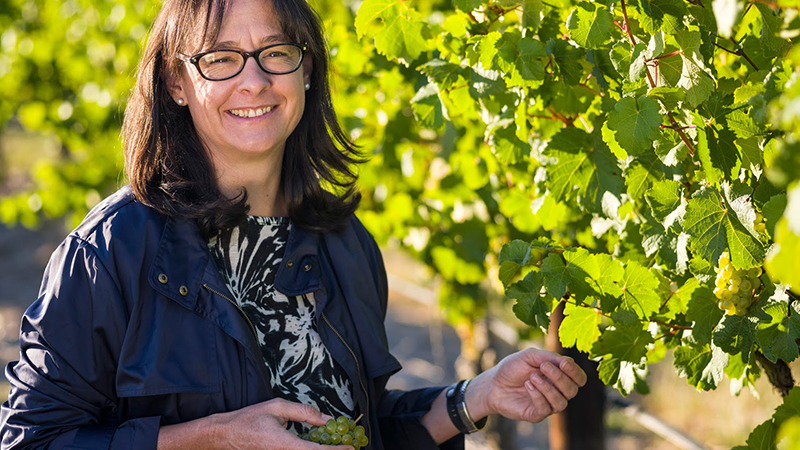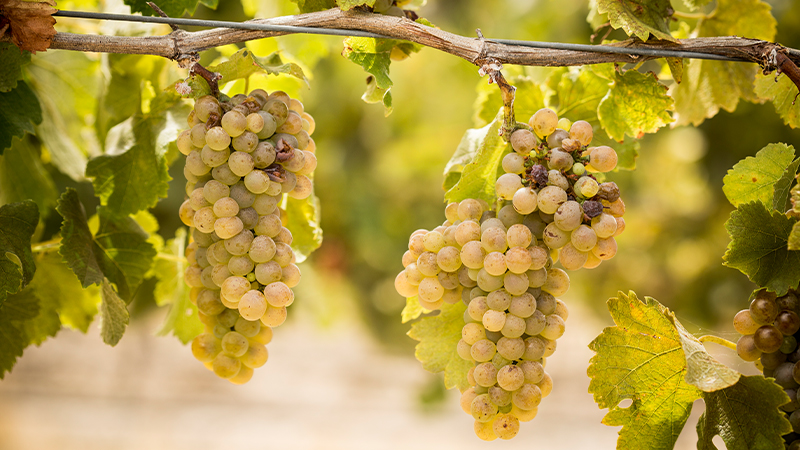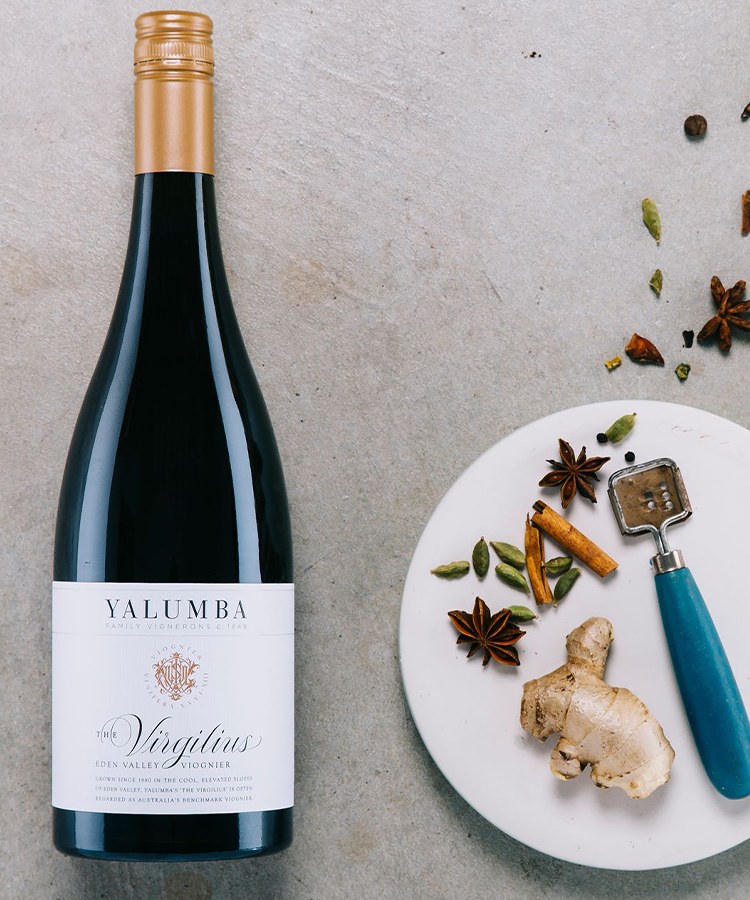
If you love white wine, you’ve probably found the usual suspects of Chardonnay, Sauvignon Blanc, or Pinot Grigio in your glass more than once. As much as we love these varieties, we’re filling our glasses with something a little less known (and equally tasty!) this spring. It’s floral, it’s refreshing, and above all, it’s seriously delicious. Any guesses?
If you placed your bet on Viognier, you hit the nail on the head. This aromatic white grape is best known for its juicy, medium- to full-bodied wines that promise to please a variety of wine lovers. For those who aren’t as familiar with the variety, fear not — we’ve got you covered just in time for International Viognier Day (April 30).
First, some quick facts: Although the origins of Viognier are a bit unknown, most viticulturists agree that the grape likely finds its origins in Croatia, from which it was then brought over to France’s Rhône Valley by the Romans. The grape was on the brink of extinction just 50 years ago, but a rise in consumer popularity caused the number of plantings to increase. Genetically speaking, Viognier is closely related to two of Piedmont’s most common red grapes, Freisa and Nebbiolo.
Today, Viognier has made quite a name for itself, despite its humble origins. It is the only grape variety used in the prestigious white wines of France’s Condrieu and Château-Grillet appellations, and it is widely included in white wine blends across the south of France. Outside Europe, the grape is cultivated in North and South America, Africa, New Zealand, and Australia, the latter of whose expressions should not be overlooked.
Which brings us to Yalumba, Australia’s oldest family-owned estate. The winery was founded in 1849 and is best known for its progressive, forward-thinking approach in both the vineyard and the cellar. Yalumba’s wines are produced at the hands of its fiercely talented chief winemaker, Louisa Rose, with grapes from the Barossa and Eden Valleys, as well as the Coonawarra and Wrattonbully regions of South Australia.

Yalumba has been following its own sustainable viticulture program in the vineyards, which it first introduced over 25 years ago. Native yeast fermentations turn the grape juice into wine, and biodiversity in the vineyards is actively encouraged, as the estate believes this fosters the growth of healthier, higher-quality fruit. As the estate tells Winebow Imports, which represents it in the U.S., “For every hectare of vineyard we own, we have at least one hectare of native vegetation.” All of Yalumba’s wines have been 100 percent vegan since the 2012 vintage.
Winemaker Louisa Rose tells VinePair that Yalumba first planted Viognier back in 1980, at a time when there was hardly any to be found across the globe. “The inspiration came from wanting to look at alternative varieties from around the world, which might be suited to our lifestyles, culture, and foods,” she explains, highlighting Yalumba’s on-site propagation nursery, which allowed (and still allows) for the study of new varieties through small, experimental vineyard plantings.
“At the time, Viognier was such an unknown variety that we didn’t have any particular expectations — it was over the following years as we experimented and learned about the variety that we came to love it,” she says. “Today, we love its flavor, versatility, and the fact that it goes so well with so many cuisines and foods.”
At VinePair, we find that Viognier wines’ rich, medium- to full-bodied palates are generally loaded with flavors of stone fruit, honeysuckle, and sweet citrus, which are often accompanied by creamy hints of vanilla after oak aging. The lush flavor profile and relatively low acidity in Viognier make it soft and juicy on the palate, rendering it the perfect match to a variety of springtime food favorites. So what makes an Aussie expression different?

Rose notes that Eden Valley Viognier expresses lots of stone fruit characters, ginger, white pepper, and some white flowers. “The Yalumba style is to [create] wines with the richness of flavor that the variety has, but to respect the low acidity and natural tannins of the grape that result in wines with freshness, structure, and length,” she says. Yalumba currently makes four expressions of Viognier, all of which are fermented with natural yeasts and stay on the lees before blending and bottling. Rose explains the differences here:
Yalumba The Virgilius Viognier
One hundred percent fermented and aged in mature French oak barrels. From our oldest Eden Valley vineyards (1980s), this is a barrel selection wine made about 10 months after harvest. The style is reserved and sophisticated, and the wine will open up and take the drinker on a journey as it evolves in the glass (or in the cellar). It is often compared to a red wine in the way that it behaves and the food and experiences that it pairs with.
(SRP $48.99)
Yalumba Samuel’s Collection Eden Valley Viognier
Fruit for this wine comes from all of our Eden Valley vineyards. About half of this wine is fermented in mature oak, while the other half is vinified in stainless-steel tanks. Like The Virgilius, it spends about 10 months on lees before blending and bottling. This wine is always open and expressive, showing lots of apricot and other Viognier flavors.
(SRP: $20.99)
Yalumba Y Series Viognier
This wine is made from vineyards from different regions in South Australia, where the range of Viognier’s flavors and characters really come together. This wine is fermented and aged for three to four months in stainless steel tanks, where the freshness and vibrancy of the variety are maintained.
(SRP: $12.99)
Yalumba Organic Viognier
This expression is made from organically certified vineyards from different regions in South Australia. It is produced very similarly to the Y Series wine, although with strictly organically grown grapes (not that our “normal” winemaking is that much different, but the organic viticultural processes are subject to auditing as they are certified).
(SRP: $18.99)
As both Rose and VinePair agree, Viognier could possibly be the best gateway white for skeptical red wine drinkers. “Viognier is like a red wine without the red,” Rose says, dubbing the wines flavorful, textured, food-friendly, and delicious. “Viognier appeals to many people: those who enjoy white wines, and often those who consider themselves red wine drinkers only,” she says, citing the grape as “particularly appealing” to those who enjoy experimenting with food, whether in their own kitchens or out at restaurants. Some of Rose’s recommended pairings include poached lobster, spicy crab rolls, pad thai, chicken tagine, barbecued pork spare ribs, ratatouille, roasted cauliflower, baba ganoush, fresh gnocchi, and more.
For a go-to spring white that promises to please a variety of palates and pair well with a plethora of foods, look no further than Yalumba Viognier, available nationwide.
